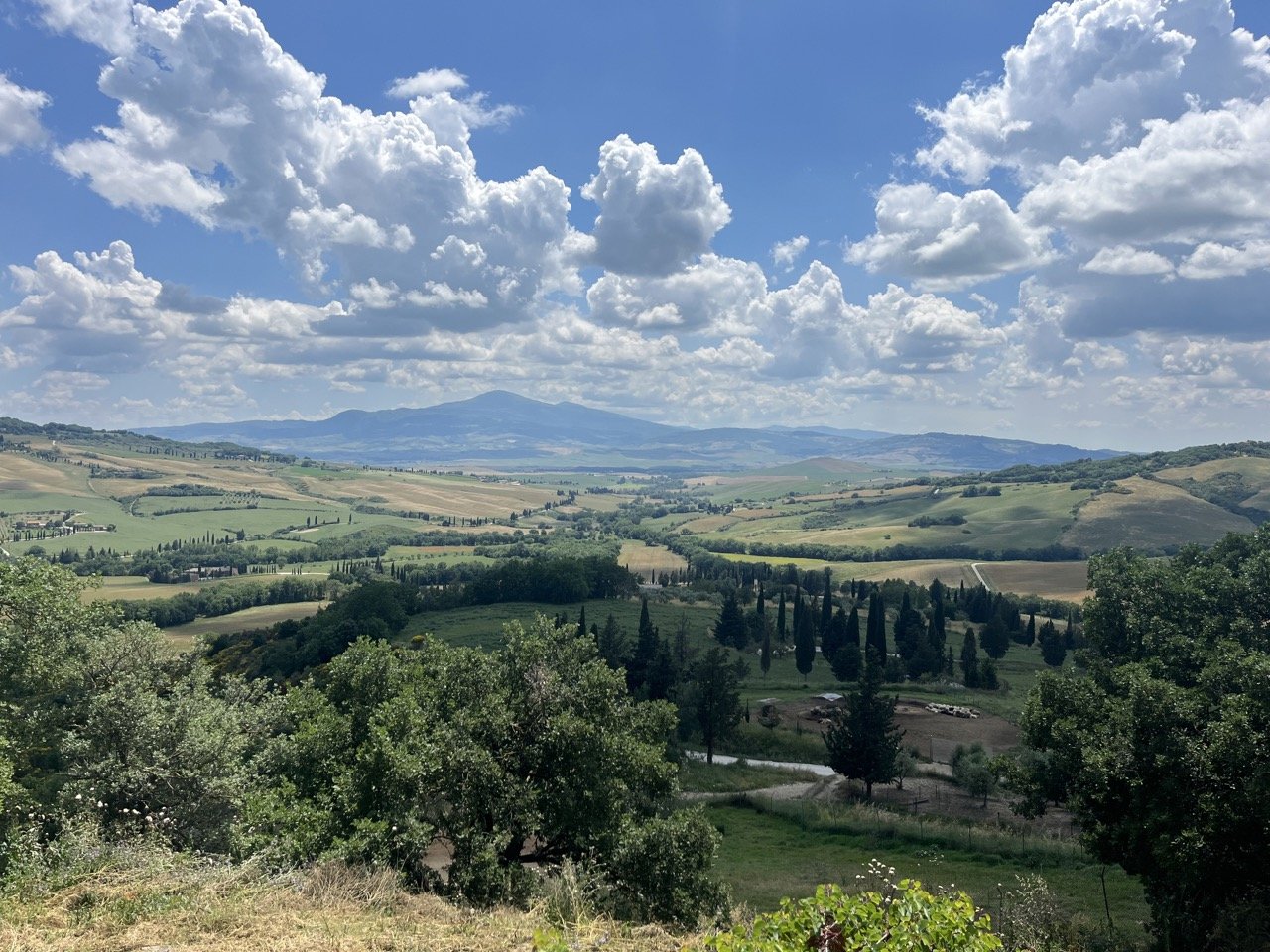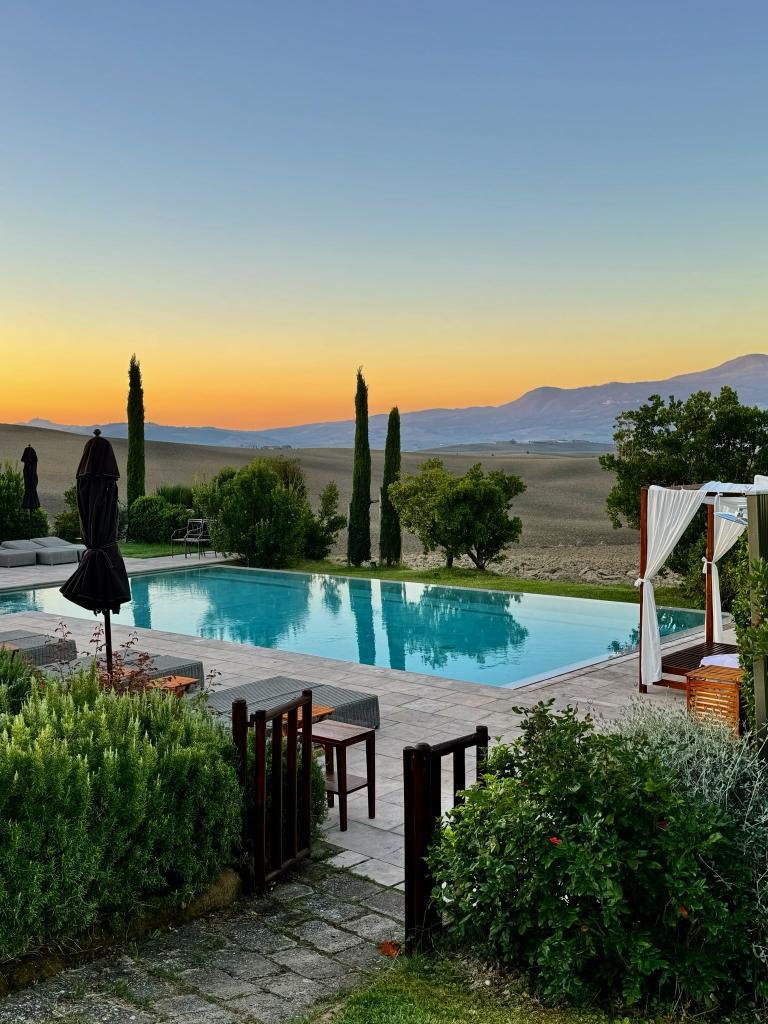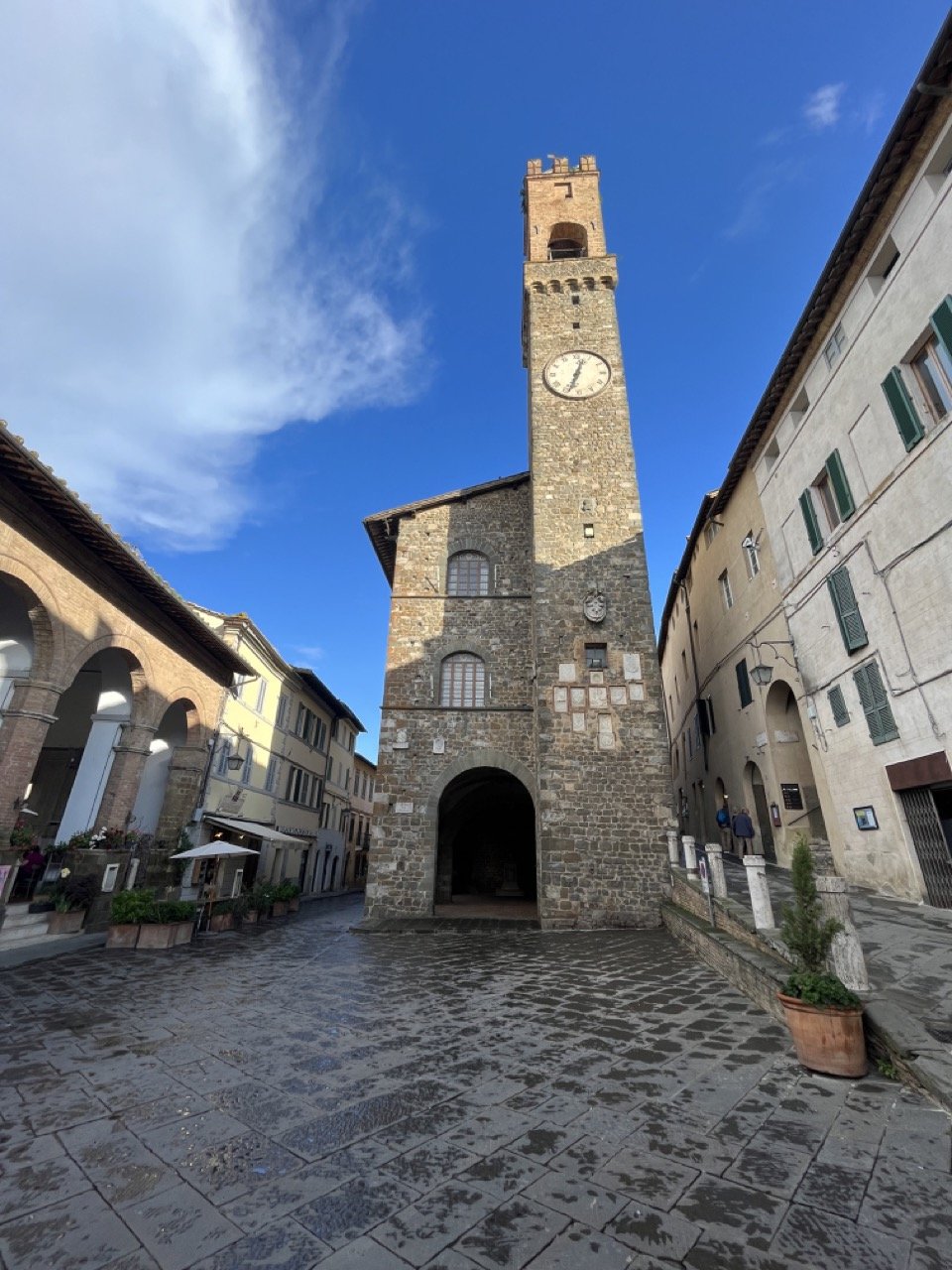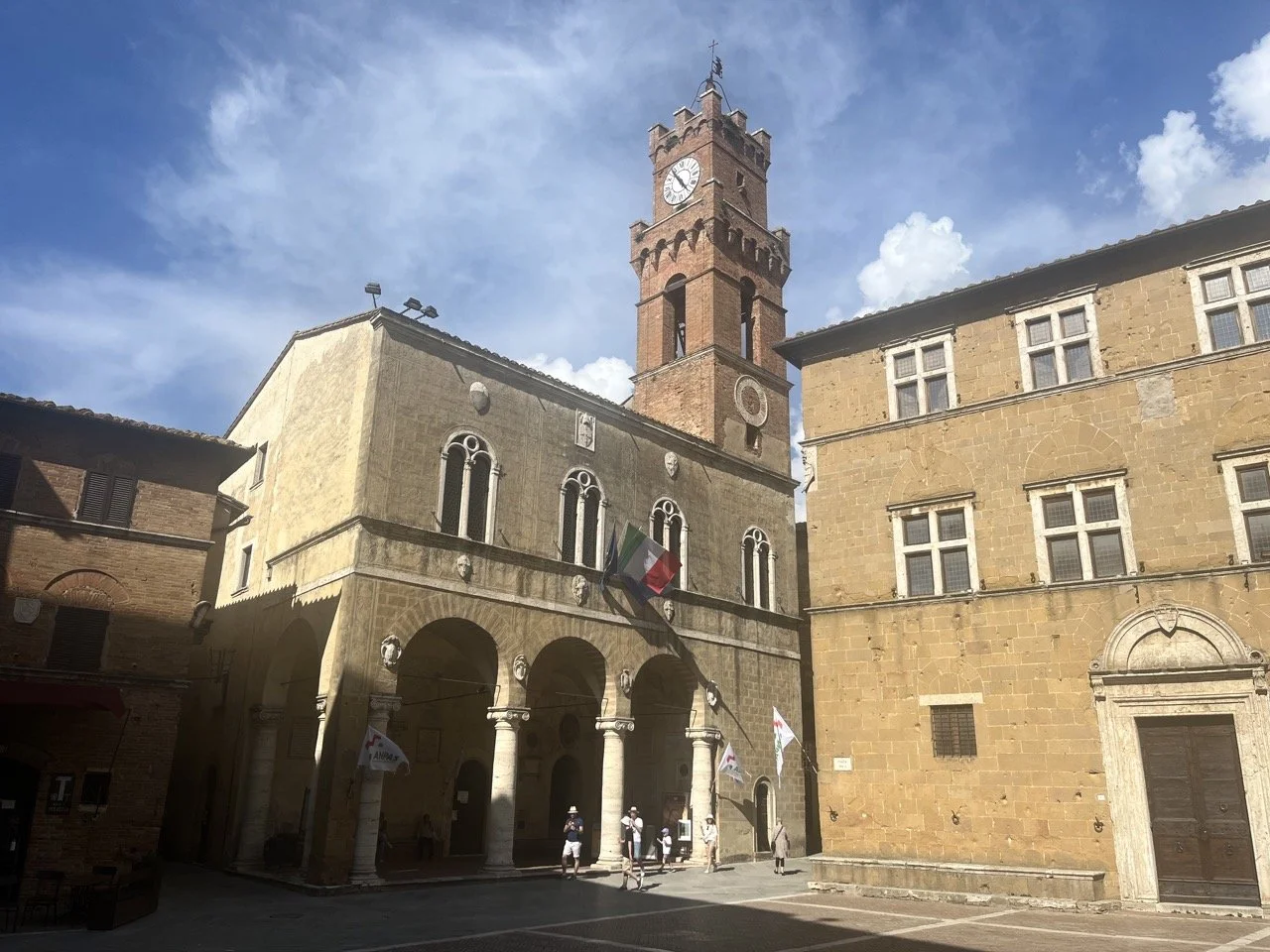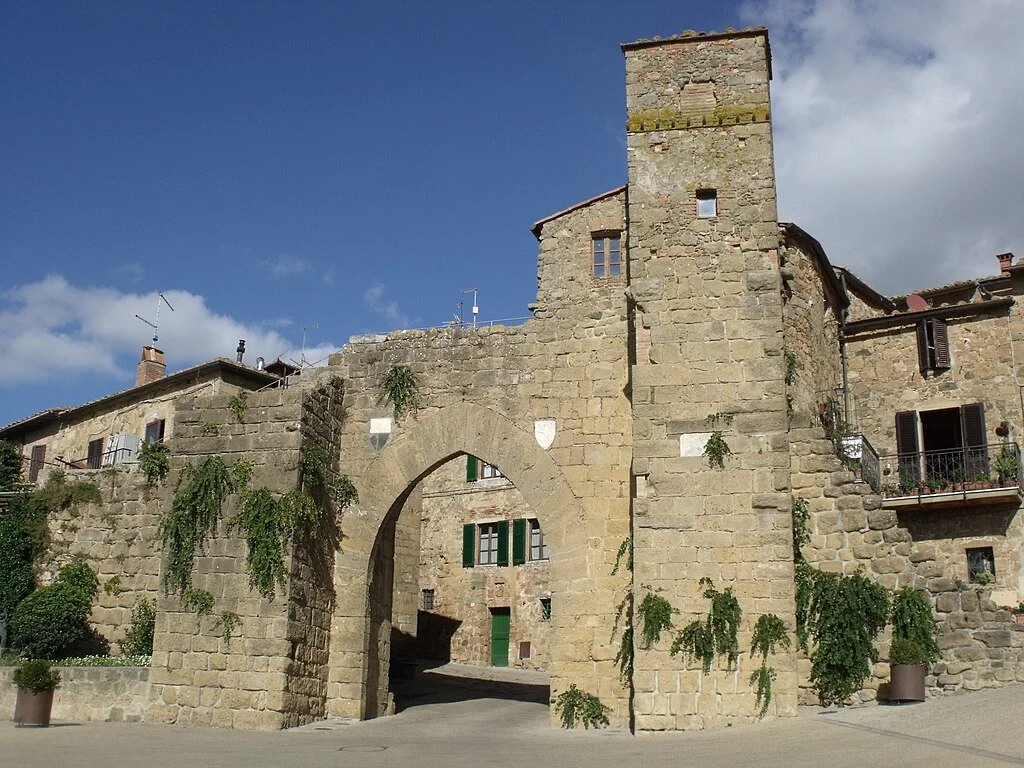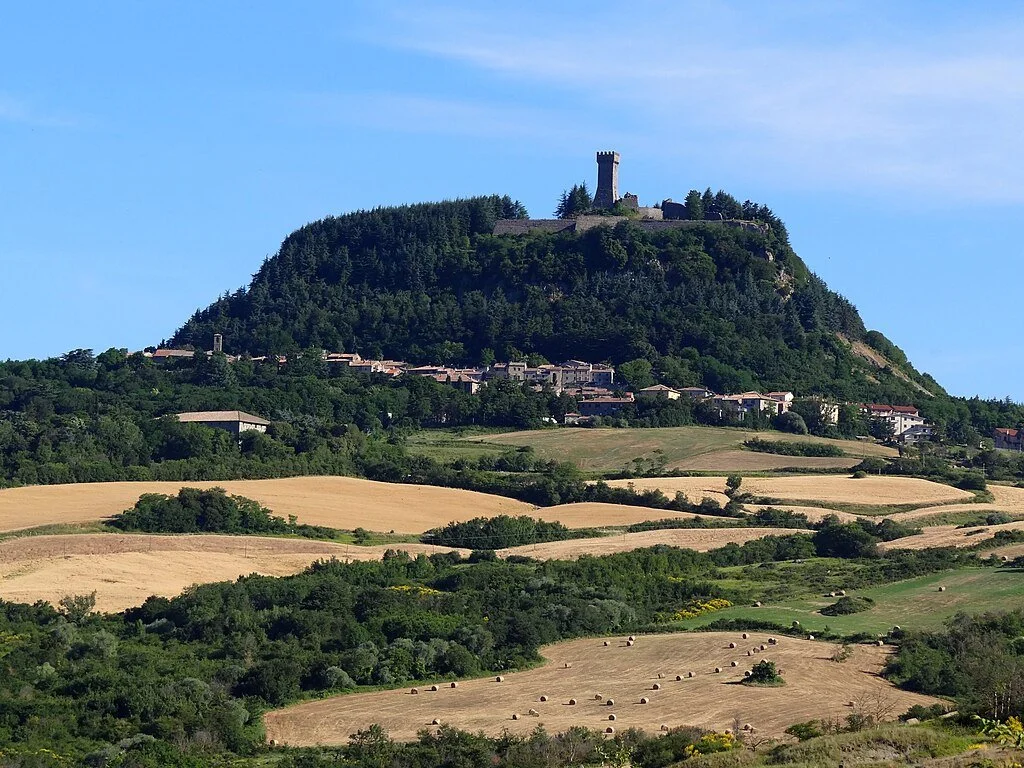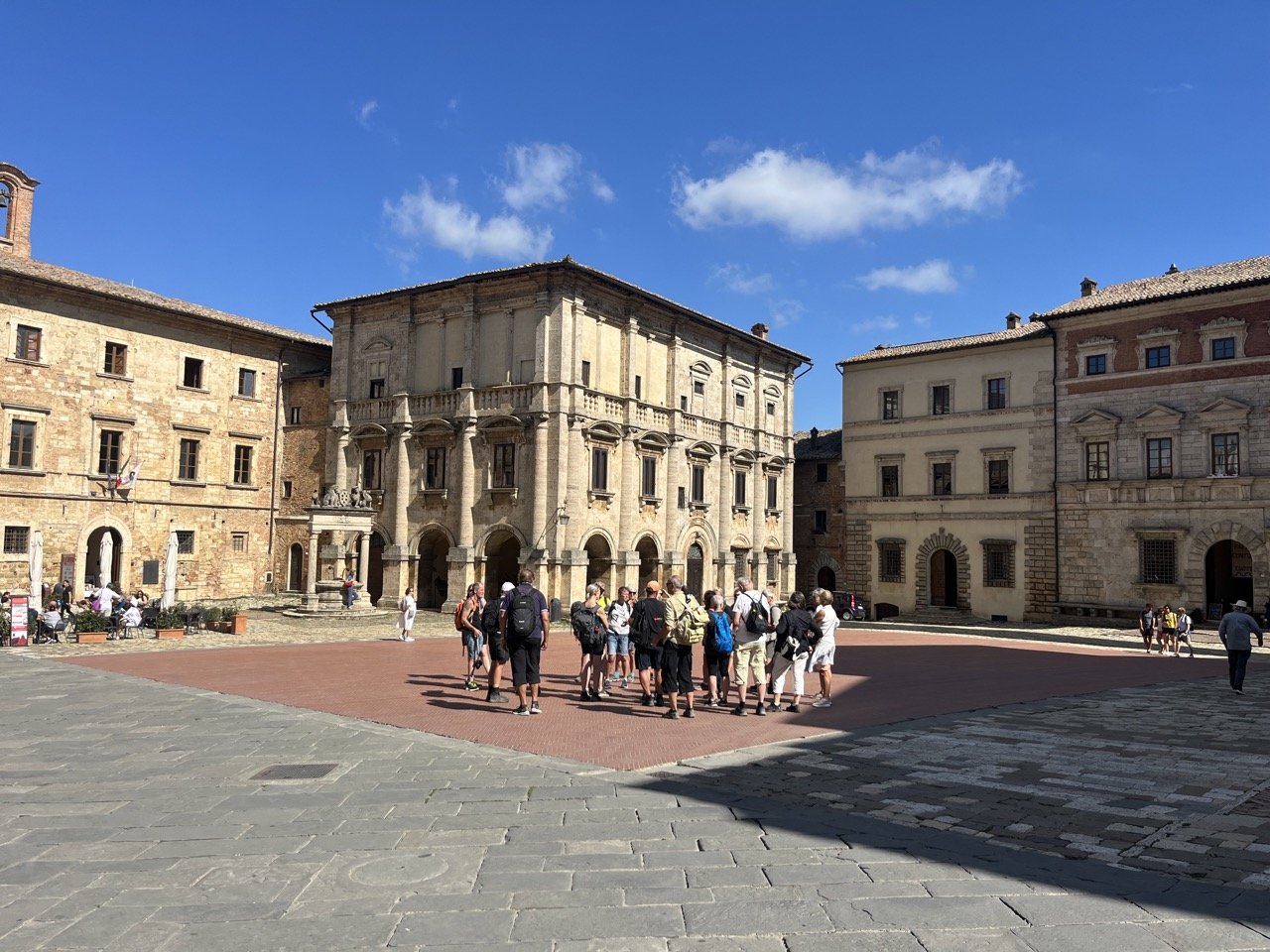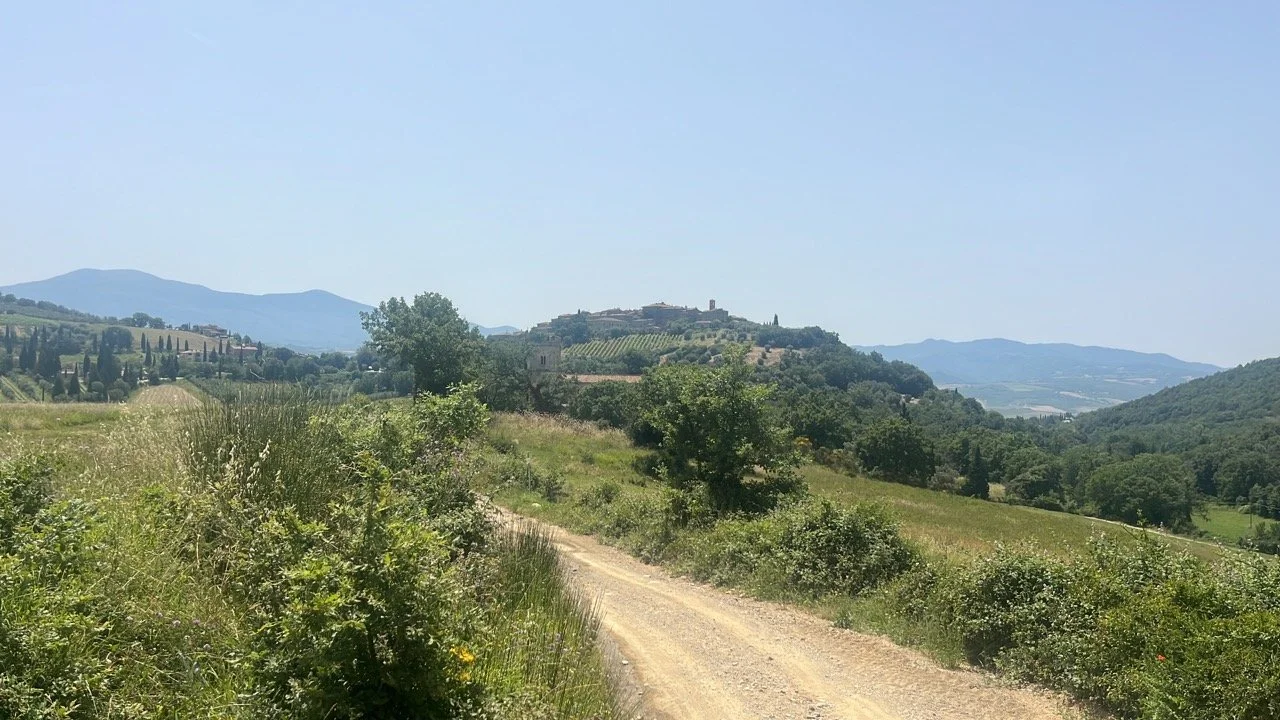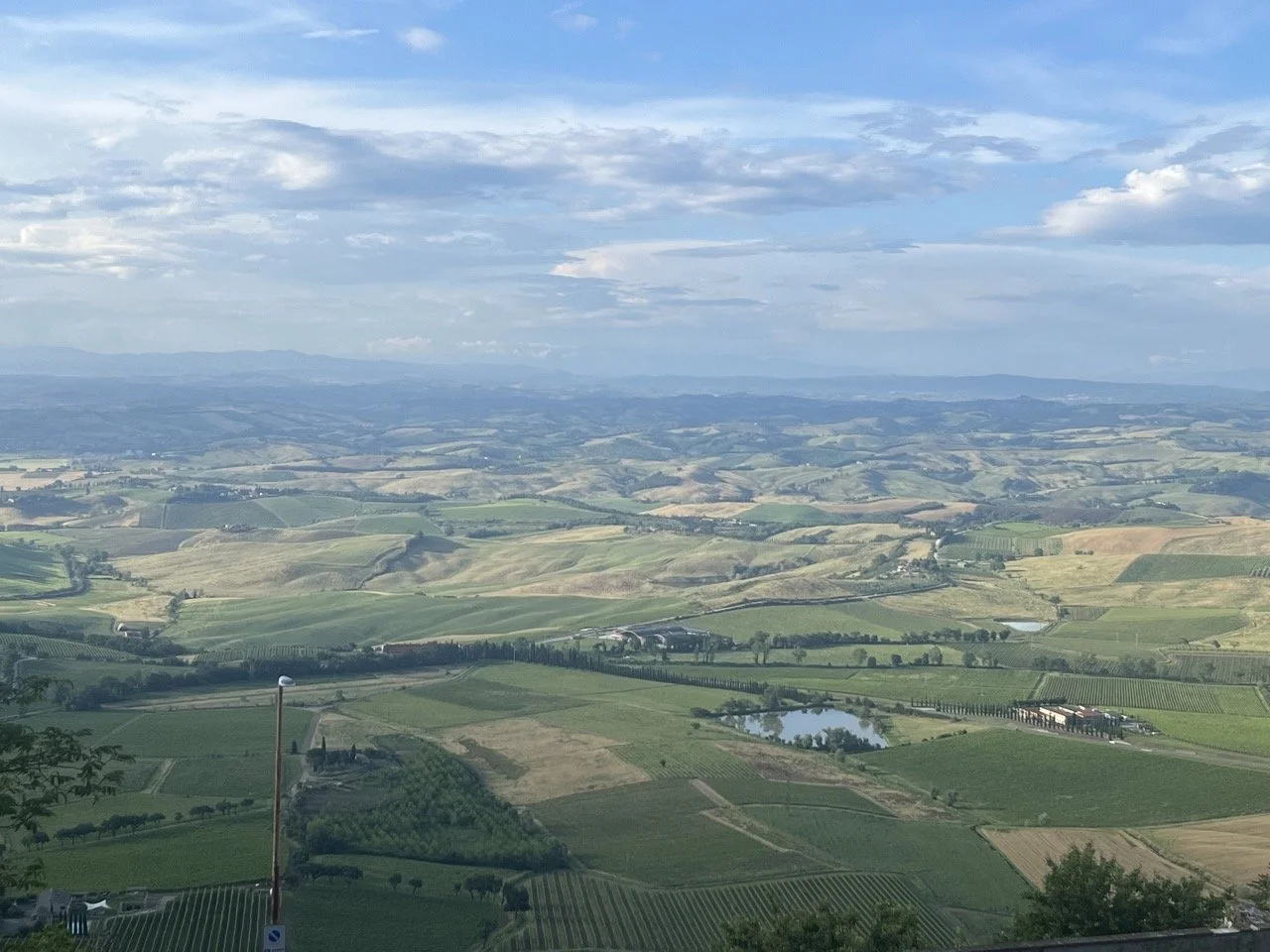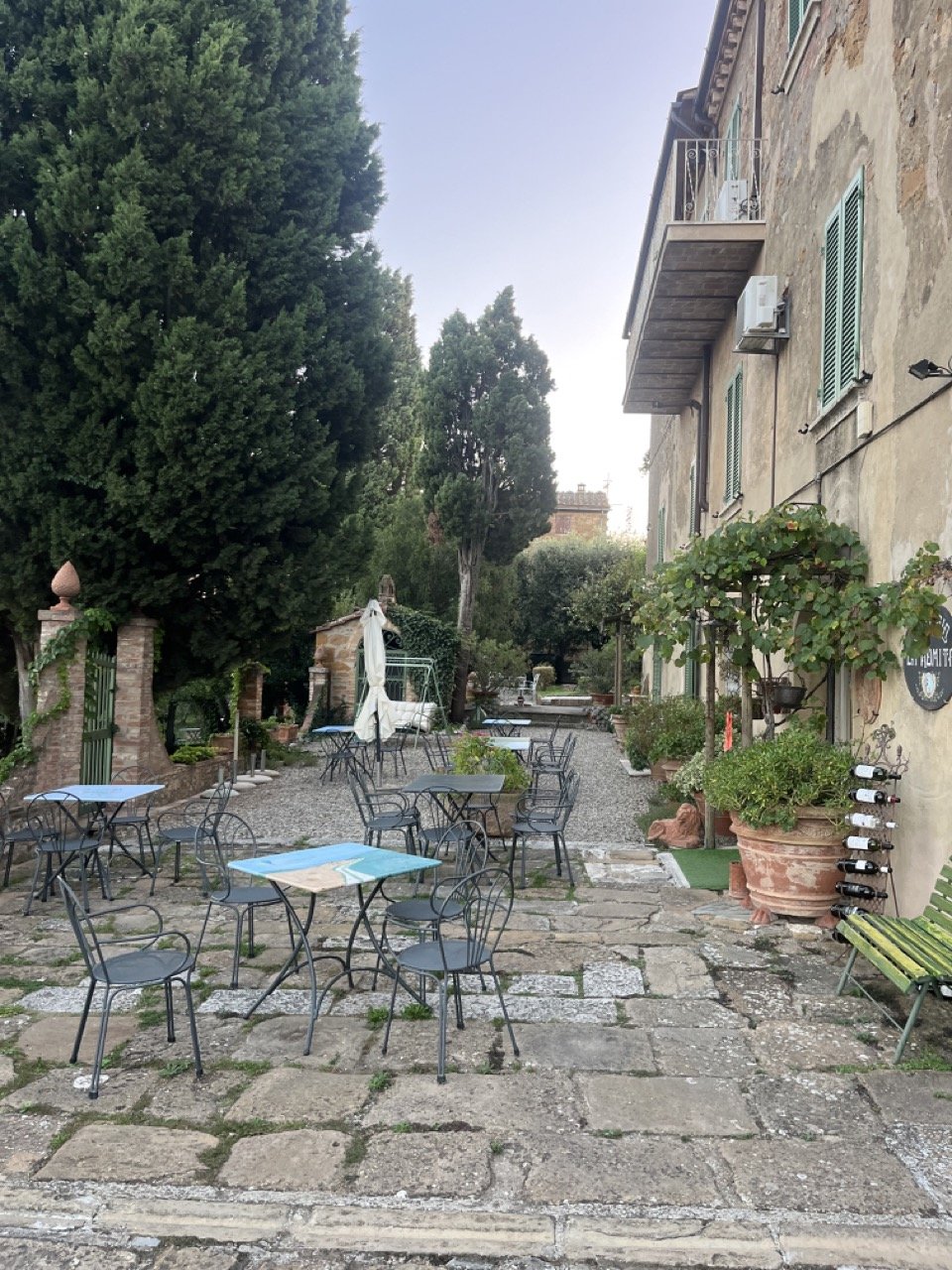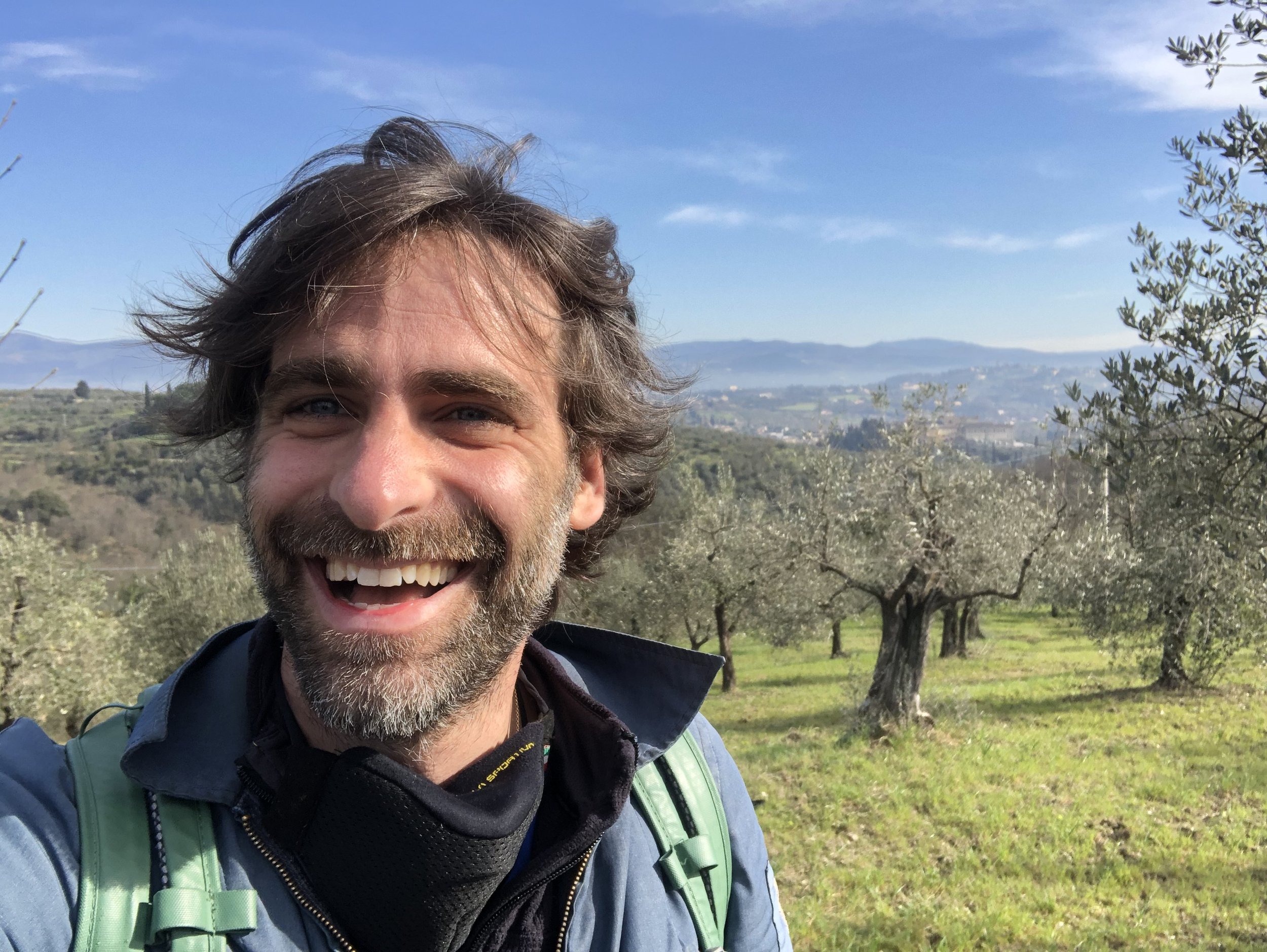Travel Guide to the Val d’Orcia, Italy
Affiliate disclosure: some of the links in this article are affiliate links. If you book using one of them, we’ll earn a small commission. All of our info is free to read and free of ads, so we appreciate it!
The composer Giuseppe Verdi once famously said “You may have the universe if I may have Italy.” It’s not much of a stretch to assume he might have been speaking about the Val d’Orcia, because few places in Italy, or on earth, for that matter, are more enchanting than this landscape of hills carpeted with golden fields and vineyards and topped here and there with storybook villages.
It only seems natural that two of Italy’s top wines, Brunello di Montalcino and Vino Nobile di Montepulciano, come out of this alluring countryside. Oenophiles might feel they’ve entered paradise when they find themselves among mile after mile of vineyards that yield these and other excellent wines.
For that matter, so will anyone who appreciates beautiful surroundings, good food, intriguing little towns, and many of the other fine things in life.
From many decades of walking the back roads around Montichiello and lingering in cafes in Pienza, I can say with conviction that like a ruby red Brunello, this is a region to be savored, and it would be a shame not to linger for a few days, or a week, or even longer.
Table of Contents
Tuscany planning cheatsheet
 Plan your itinerary with expert advice
Plan your itinerary with expert advice
- Book an Italy travel consultation with a local expert
 My favorite hotels in Tuscany
My favorite hotels in Tuscany
- Hotel Calimala - Gorgeous boutique hotel in Florence's historic center. $250-450 USD
- Locanda de Ciomp - Excellent value guesthouse in Florence. $150-200 USD
- Palazzo Ravizza - Lovely midrange option in Siena. $120-175 USD
- Castello di Fonterutoli - Delightful castle & winery resort in the Chianti countryside. $200-300 USD
- Meublé il Riccio - Historic property in the heart of Montepulciano. $160 USD
- La Casa Di Adelina - Charming B&B in the Val d'Orcia village of Montichiello. $130 USD
 Guided tours and activities
Guided tours and activities
 How to get around
How to get around
- Car rentals with DiscoverCars
- Train tickets from Trenitalia and Italo
- Bus routes via Autolinee Toscane, Sitabus, and Flixbus
What is the Val d’Orcia
The Val d’Orcia (Orcia valley in English) is a rural landscape of rolling hills and valleys that stretches south from Siena to Monte Amiata in southern Tuscany.
Much of the region’s timeless beauty can be traced to the Renaissance, when the wealthy lords of Siena established a network of prosperous farms throughout the region and built fortified towns, villas, churches, and abbeys that have remained unchanged over the centuries.
Most of this landscape is now protected as part of the 163,000-acre (66,000-hectare) Parco Artistico Naturale e Culturale della Val d’Orcia, a UNESCO World Heritage site.
The region produces wine, of which Brunello of Montalcino and Vino Nobile di Montepulciano are the most highly prized, as well as olives, fruit, and other crops. Sheep graze in meadows and produce pecorino cheese, for which Pienza especially is noted.
Artists and photographers find inspiration in the farmlands, hilltop villages, and cypress-lined lanes, just as many noted painters of the Renaissance did before them.
Traveling down the quiet country lanes of Val d’Orcia from one pretty village to the next, taking in the vistas and maybe snapping a photo or two, is one of the great pleasures of exploring Tuscany.
Where is the Val d’Orcia
The Val d’Orcia rises and falls across a mountainous swath of central Italy lying just south of Siena and west of the Val di Chiana (Chiana valley).
While not an official Italian region, all of the area of the Val d’Orcia comes under the auspices of the Province of Siena and it encompasses territory around five main towns: Pienza, San Quirico d’Orcia, Montalcino, Bagno Vignoni, and Radicofani.
All of these towns are within easy reach of Siena; San Quirico d'Orcia and Montalcino are only about 40km (25 miles) south, while the most distant, Radicofani, is 72km (45 miles) south.
How to get here
By car
The only easy way to get to and around the Val d’Orcia is by car. It’s a quick drive up from Rome, about two hours to Pienza on the A1 autostrada, exiting at the town of Chiusi-Chianciano Terme.
It’s about an hour and a half from Florence, on the A1 to the Betolle exit.
The drive from Siena is less than an hour on the SR2.
Driving around the region, on scenic two-lane roads, is pleasant and places are close together, so once there, handy as a car is, you won’t need to spend a lot of time behind the wheel if you don’t want to.
Where to rent a car:
If you plan on renting a car, I also always recommend checking prices on DiscoverCars. It’s a car rental website that includes offerings from all the major international rental companies as well as lots of smaller local agencies, which often have much better pricing.
By public transport
Although none of the towns of the Val d’Orcia has a train station, the nearby town of Chianciano Terme does. If you’re trying to get to the Val d’Orcia using public transport, you can take a train to the Chiusi-Chianciano Terme station that has frequent service from both Rome and Florence.
From Rome, trains run hourly and the trip takes about an hour and a half. From Florence, trains depart a bit more frequently, about every 45 minutes, and the trip takes 1.5 to 2 hours.
From Chianciano Terme you can take a bus to Pienza, Montalcino, and other towns, but service is infrequent, and once you settle in, you won’t have many options for getting around without a car. You might consider renting a car in Chianciano Terme and dropping it back off there when you’re ready to move on.
By guided tour
If you won’t have a car (or if you want to be able to try all the great wine you’ll be passing by), the easiest way to visit the Val d’Orcia is via guided tour. While there are plenty of big bus tours that will take you to a few of the Val d’Orcia towns, most unfortunately won’t give you the chance to get out into the countryside.
A private guided tour is a lot more fun and also much more flexible. For guided tours, I recommend Stefano, a Florence-based sommelier and outdoors guide, or Serena, who is based in Montepulciano.
Best time to visit
When you should visit the Val d’Orcia depends on how you want to spend your time.
Late spring and summer are the most appealing if you want to be outdoors, and you probably will here—walking, cycling, visiting vineyards, or sitting next to the pool at one of the many rural accommodations.
The good news is that while the region is popular for summer getaways, it does not become nearly as crowded as Florence and other tourist cities, or seaside regions like the Amalfi Coast and Sardinia that are top vacation spots for Italians.
Fall is still pleasant, with temperatures well into 20s C (70s F) through September, and a visit might come with a chance to see the wine harvest.
Winters are usually damp and chilly. The towns seem especially cozy and atmospheric at this time, and many hotels and restaurants remain open, but those beautiful landscapes, a sweep of gold and green in nice weather, tend to be gray and a bit bleak.
Unpaved country roads and paths can become immersed in mud, so this is not always a good time for hiking and cycling. On the other hand, nothing takes off the chill like a soak in one the region’s hot springs.
How long to spend
The Val d’Orcia is increasingly popular with day trippers who come out from Siena or Florence to see the countryside, visit a winery or two, and poke around Pienza and the other towns. That can be a good introduction to the region, but this is really a place to settle in for a week or two, because there’s so much to do.
You could easily spend a day walking from Montalcino out to the Abbey of Sant’Antimo, another making the hike or bike ride from Pienza to Montichiello, another soaking in the thermal waters of Bagno Vignoni and Bagni San Filippo, yet another visiting some vineyards… and on and on.
The region is also a convenient base for visiting other parts of Tuscany, so you could see a lot on a longer stay. It’s about an hour’s drive to the Chianti region, less than that to Siena, and about an hour and a half to Florence. The appealing, art-filled towns of Cortona and Arezzo are about 45 minutes away across the Val di Chiana.
Where to stay
You can be pretty sure that wherever you stay in the Val d’Orcia your accommodation will be loaded with character, since many are in old farmhouses amid scenic countryside or in centuries-old dwellings in the attractive towns.
Many rural accommodations are agriturismi, working farms that host guests, often with some luxury. Guests are usually treated to vegetables, fruit, and often cheese and wine from the property during a stay.
Although accommodations are rarely right in any of the towns, most are within an easy walk or at least a short drive away, and many have pools and extensive grounds that make them especially pleasant for a summer stay.
In general, I think that choosing the area in or around Pienza or Montichiello is ideal, as this puts you about equidistant from from Montalcino on the western side of the region and Montepulciano on the eastern side. Practically everywhere you’ll want to go is 15-30 minutes away.
Here are some choices that show the range of accommodations available. Prices are per night for two guests, unless otherwise noted.
Castello Banfi Wine Resort - One of Tuscany’s major wine estates pampers guests in luxurious quarters and serves refined meals paired with estate wines. From 600 euros.
L’Olmo - This 4-star hotel is set in a stunning patch of countryside just a few minutes outside of Pienza and Montichiello. With only 8 rooms, a gorgeous pool, and surrounded by rolling fields and pasture, it’s one of the most relaxing places to stay in the region. It’s expensive (rooms start at 350 euros a night), but fabulous.
La Bandita Townhouse - The most chic accommodation in Pienza, and maybe all of the Val d’Orcia, this intimate hotel is stylishly and comfortably decorated and rooms have luxuries like deep soaking tubs. Their restaurant is also superb. From 300 euros a night.
Fonte Bertusi - Charming apartments, all with outdoor spaces, are set in cottages around an estate outside Pienza. Many of the ingredients of the excellent breakfast are from the farm gardens and orchards. From 180 euros.
Albergo Il Giglio - A centuries-old inn, with a cozy lounge for sipping Brunello, captures all the atmosphere of medieval Montalcino. From 160 euros.
Agriturismo Terrapille - A beautifully restored farmhouse outside Pienza houses guests in large suites and apartments. From 120 euros.
Agriturismo la Bruciata - Glorious landscapes surround these gracious apartments on a farm between Montepulciano and Pienza. Meals are available to guests and include fruit, vegetables, and wine from the farm. From 650 euros a week.
La Casa di Adelina - Antiques-filled rooms in an old house are as charming as the setting, the walled village of Montichiello. From 100 euros.
Towns to visit
The five major towns of the Val d’Orcia are mostly devoted to wine and other agriculture. They’re all extremely attractive and quite small—Montalcino, the largest, has a population of only 5,000 people, while most have only 2,000 or so residents.
They’re fairly close to one another; in fact, on a drive of less than an hour you can pass through all of them except Radicofani, the outlier in the south of the region.
Bagno Vignoni
Like many other small villages, this handsome collection of houses and churches about 7km (4 ½ miles) south of San Quirico d’Orcia surrounds a central piazza, only the one here is entirely taken up with a pool of thermal water, fed by underground springs.
Roman legionnaires, Lorenzo Medici, and Saint Catherine of Siena are among those who have come here to soak their weary bones, and modern-day visitors set their sights on several spa hotels.
Montalcino
A tower rises from the Piazza del Popolo at the town center and above it all is a mighty fortress. But the greatest claim to fame for this handsome town, 40km (25 miles) south of Siena, are the vineyards that stretch away in every direction.
They produce Brunello di Montalcino, one of the world’s most acclaimed red wines.
Pienza
Shops along the little lanes sell percorino (sheep’s milk cheese), honey, and other bounty from local farms, but homey atmosphere aside, this pretty little village 23km (14 miles) east of Montalcino has a noble heritage.
Pope Pius II redesigned his birthplace in the 15th century as an ideal Renaissance city, as you’ll see in the harmonious design of the palaces and cathedral. Views over the countryside are subline, too.
San Quirico d’Orcia
This small, picturesque village halfway between Pienza and Montalcino is ringed with fortified walls and rows of cypress trees stand above the surrounding countryside.
Stately gardens, the Horti Leonini, surround the church of Santa Maria Assunta, and the elegant little Chapel of Vitaleta sits atop a hill just outside of town.
Montichiello
8km (5 miles) east of Pienza, Montichiello seems like a stage set; approached by a cypress-lined road, surrounded by walls, and huddling beneath medieval towers. In fact, Montichiello becomes a stage in August, when residents enact a theatrical performance with the village as the backdrop.
The town gate has a lovely panoramic viewpoint in front of it that offers stunning sunset views.
Radicofani
Photo: Bjørn Christian Tørrissen, CC BY-SA 3.0, via Wikimedia Commons
This high hill town, where stone houses surround an airy piazza, is topped by the remarkable Rocca di Radicofani. The mighty fortress crowns a 914-meter (3,000-foot) summit and commands views across much of southern Tuscany.
A 12th-century noble resident of the fortress, Ghino di Tacco, was a brigand known as Tuscany’s Robin Hood for his courtly manners and commitment to robbing only from the wealthy.


Notable nearby towns & villages
The following list of towns and villages includes places that are near to, but technically not part of the Val d’Orcia. Some of them are little hamlets that, while once a proper town, now actually fall within the municipality of the large towns mentioned above. Regardless, they are lovely, nearby, and well worth visiting!
Castiglione d’Orcia and Rocca d’Orcia
These two twin villages sit on adjacent hilltops about 13km (8 miles) east of Montalcino, both commanding high ground beneath imposing fortresses that were military outposts in the ongoing conflicts between Florence and Siena.
Legend has it that Saint Catherine of Siena retreated to Rocca in 1377 to pray and fast, and while there the formerly illiterate young woman miraculously received the ability to read and write.
Vivo d’Orcia
Vivo d’Orcia is a mountain hamlet set in chestnut woods among rushing streams on the slopes of Monte Amiato (the wooded mountain that dominates the horizon all over the Val d’Orcia).
Modest stone houses surround the walls of the impressive Palazzo Cervini, and the Ermicciolo (Hermitage) is a rustic church set in woods on the banks of the River Vivo just outside of town.
Montepulciano
Although not officially part of the Val d’Orcia, this handsome hill town sits right at the edge of the region, only 14 1/2km (9 miles) east of Pienza. You’ll probably drive around Montepulciano if you approach the Val d’Orcia from the south or east.
On the main street it’s all uphill from the Porta al Prato to airy Piazza Maggiore, the high point of this high town, graced with the Duomo and Palazzo Comunale. On the way up are many enoteca serving the town’s Nobile di Montepulicano and Rosso di Montepulciano wines.
Buonconvento
In a region of barren hills just south of Siena known as the Crete Senesi (clay hills), Buonconvento is a lovely old town completely enclosed within a circuit of walls. You’ll probably pass through Buonconvento if you’re driving from Siena to Montalcino, just 14km (7 miles) south.
The town, like many in the Val d’Orcia, is on the Via Francigena pilgrimage route.
San Giovanni d’Asso
This tiny little town is also technically in the region known as the Crete Senesi but it’s right on the border of the Val d’Orcia, only 16km (10 miles) north of San Querico d’Orcia. Regardless of what region it’s a part of, the sight of earth-colored, tile-roofed houses climbing a hill beneath a castle is too pretty to miss.
The town is famous for truffles (white ones in particular), celebrated at a truffle museum in the town’s castle and at a truffle festival in late October/early November.
Things to do in the Val d’Orcia
1. Hop between villages
The Val d’Orcia is a rural area and there are no cities here. The towns of the region are also small, and if we’re being honest there isn’t really much to see or do in any of them. This is not an area that you come to for monuments, museums, and places to hit on your checklist. But that’s also what’s so pleasant about it!
Most towns can be visited in an hour or two and the scenery between them is stunning, making for fabulous road trip days by car, motorcycle, vespa, or bike.
2. Soak in some hotsprings
Bagno Vignoni and Bagni San Filippo are noted for their thermal waters. In Bagno Vignoni, the Terme Spa and Resort and the hotel Posta Marcucci are two spas that channel the hot waters into thermal pools. Hotel guests have free access while non-guests can access them for a fee.
Alternatively, you can soak for free just below town in hot waters that are channeled into pools along a path beside the Orcia River as it courses past ancient mills preserved in the Parco dei Mulini (Park of the Mills).
Outside Bagni San Filippo, a path through the woods - the Sentiero di Fosso Bianco - leads to a series of hot-spring pools, including one beneath a formidable calcified waterfall known as the Bocca di Balena (Whale’s Mouth).
3. Take a hike along the Via Francigena
The Via Francigena, the route that medieval pilgrims followed from Canterbury, England, to Rome, traverses the Val d’Orcia. Paths fall and rise across the countryside from Siena to Radicofani, covering about 103km (64 miles).
The 32km (20-mile) segment from San Quirico d’Orcia to Radicofani is especially popular with hikers. Unpaved farm roads, excellent for hiking and biking, connect many villages in the region, including a 14km (8 1/2-mile) loop from Pienza to Montichiello and back.
4. Go cycling
The Val d’Orcia is popular with cyclists, with dozens of routes along paved secondary roads and gravel paths. The most strenuous routes include the climb up the slopes of Mount Amiata to lung-challenging heights, while gentler rides are around Pienza and San Quirico d’Orcia.
Road bike and e-bike rentals are plentiful, as are guided bike tours and shuttle services for bikers. Given the hilly terrain, an e-bike is an attractive option.
5. Savor the Tranquility of the Abbey of Sant’Antimo
Pilgrims looking for a rest stop as they plied the Via Francigena route to and from Rome have long set their sights on this monastery and abbey built of gleaming travertine stone and alabaster outside Montalcino.
It’s said that Charlemagne funded part of the construction of the elegant church, having sought refuge here to avoid an outbreak of the plague in 781.
A popular excursion is the walk of abut 10km (6 miles) through beautiful countryside from Montalcino to the abbey and back.
6. Ascend Monte Amiata
This volcanic dome rises to 1,738 meters (5,700 feet) and is visible from many places in the Val d’Orcia. The road to the top passes through the town of Abbadia San Salvatore, worth a stop for the namesake eighth-century abbey, then winds through chestnut forests toward the summit. From road’s end a path leads to a lookout point beneath a towering iron cross.
7. Enjoy the views
Two of the most dramatic outlooks, across a huge swath of southern Tuscany, are from the top of Monte Amiata and the cliff-edge fortress of Radicofani. Gentler, more soothing views in this beautiful part of the world take in swaths of rolling hills, rows of cypress trees, and villas and little villages crowning the occasional hilltop.
You’ll get an eyeful of these scenes on the drive along SP146 between Pienza and San Quirico, with an especially dramatic prospect of cypress trees climbing a hillside as you approach San Quirico. Another view-filled road is the one from Pienza to the little village of Montichiello, through countryside where cypresses crisscross the golden hills.
8. Visit the gardens at La Foce
La Foce is the creation of Iris and Clemente Origo, who in the 1920s began establishing an extensive estate around a villa that was once a hospice for pilgrims on the Via Francigena.
In addition to creating extensive Renaissance gardens, the Origos also oversaw farmlands employing dozens of families, for whom they built housing and a school.
The garden is open Wednesday afternoons and Sundays by appointment. Bosco Isabella follows the walls of Radicofani for 1.5km (about a mile), creating a quite retreat where stone pyramids and other elements appear in the well-tended wilderness.
9. Eat a whole lot of cheese
Farms around Pienza produce percorino, a hard cheese made from sheep’s milk. The ones here, the famed Pecorino di Pienza, are said to be tastier than other pecorinos because of the aromatic qualities of the grass and herbs on which the sheep graze.
You can see the production process, taste the output, and enjoy cooking classes at Podere il Casale outside Pienza. Their on-site restaurant has one of the most splendid views of anywhere in the Val d’Orcia. If coming in summer or early fall, do be aware that the flies can be intense though.
La Taverna del Pecorino, Marusco e Maria, and La Vecchia Bottega are among the cheese shops in town that sell the local product. In September Pienza stages the Fiera del Cacio, a festival spotlighting cheese and other local food and wine.
The highlight is the Palio del Cacio Fuso, in which opposing teams roll rounds of pecorino around a wooden post in the main square.
10. Taste the local wines
Two of the most acclaimed wines of Italy are produced in the Val d’Orcia, bold-flavored Brunello di Montalcino and Vino Nobile di Montepulciano. The region also has its own appellation, the Orcia DOC, setting quality standards for wines grown in the region from 60 percent Sangiovese grapes.
What all this means is that there is a lot of excellent wine to be enjoyed. Many wineries offer tastings, and some pair wines with local cuisine. If you’re in the Val d’Orcia the last weekend in April, you’ll get a good introduction to Orcia DOCs at the Orcia wine festival in San Querico d’Orcia.
For detailed info on wine and wineries in the area, check out our guide to wine in the Val d’Orcia.
Here are a few of my favorite wineries:
Avignonesi, in the hamlet of Valiano di Montepulciano, produces a large range of reds, whites, and roses classified as IGTs, for Indicazione Geografica Tipica, a category that places few restrictions outside the Tuscan geographic designation and some levels of quality, as well as vin santo and grappa.
Sample these at tastings or at a gourmet lunch in which the estate wines are paired with menus. They also offer cooking classes that end with a four-course meal paired with the best wines.
Corte Pavone Winery, at the end of a cypress-lined drive west of Montalcino, hosts tastings of its Brunello as well as Rosso del Montalcino, made with the same grapes but aged for a shorter period, along with a refreshing Spumante.
Enotecca la Fortessa, within the walls of Montalcino’s fortress, is an atmospheric setting in which to sample Brunello, accompanied by locally made cheeses and salamis. The shop sells wines from throughout the region.
Le Buche, at the eastern edge of the Val d’Orcia north of Bagno San Filippo, shows off its Orcia DOC reds and whites and other wines with hospitality that includes picnic tastings and e-bike tours of the vineyards with a stop in the tasting rooms.
Poggio Antico, a legendary producer of Brunello, hosts tastings and tours at its beautiful vineyards outside Montalcino.
Sasso di Sole, outside Montalcino, produces Brunello as well as wines of the Orcia DOC, so tastings provide a good introduction to both.
Tenuta Castelnuovo Tancredi, outside Buonconvento, specializes in Orcia DOC wines, experienced on hour-long tours of the cellars that end with a tasting.

Connect with Serena in Montepulciano for help perfecting your itinerary, answers to all your travel questions, and fabulous local tips for a better visit!
Restaurants and dining
You’ll enjoy typical Tuscan fare in the Val d’Orcia. This means salumi (cured meats), game, and steak (including bistecca alla Fiorentina which comes the adjoining Val di Chiana valley).
Traditional peasant fare is elevated to haute cuisine in dishes such as ribollita, in which leftover bread is added to bean soup. Pici, the short pasta typical of the Siena region, is often served here all’aglione, with a sauce of anchovies and hot pepper and topped with breadcrumbs.
Some restaurants worth seeking out include:
La Bandita Townhouse in Pienza is the restaurant within the hotel of the same name. Fitted out with furnishings from a 1950s-era Florentine schoolhouse, they serve memorable hamburgers made from Val di Chiana beef, Tuscan pastas, steaks, and other local fare made with international and modern twists. Dinner for two is about 140 euros.
Dopolavoro La Foce, in a former farm social hall amid the fields and gardens of the beautiful La Foce estate, serves refined Tuscan fare, with a big choice of grilled meats, accompanied by wines produced on the property. Dinner for two is about 100 euros.
At Il Griglio, on the main street of medieval Montalcino, a blazing hearth in cooler months and views over the town and countryside are the backdrop for meals of game, pasta with a sauce of wild boar, and other Tuscan classics, accompanied by Brunello from the surrounding vineyards. Dinner for two is about 80 euros.
La Porta is next to the main gate of Montichiello, and the kitchen does justice to the picturesque setting with big servings of pici and excellent steaks. Dinner for two is about 70 euros.
Locanda di Fonte alla Vena is a cozy trattoria just outside the historic center of San Querico d’Orcia, serving hearty pastas and grilled meats that match the rustic ambiance. Dinner for two is about 70 euros.
Osteria del Leone, in Bagno Vignoni, serves game dishes, pastas with truffles, and other innovative takes on Tuscan cuisine in similarly refined surroundings. Dinner for two is about 80 euros.
At Trattoria da Fiorella, a converted stable in Pienza, the town’s pecorino cheese tops zucchini-stuffed crepes, grilled vegetables, and other dishes. Dinner for two is about 70 euros.
La Romita is a hidden gem in the tiny village of Montisi, deep in the woods and hills beyond the town of Montefollonico. Here, for over 40 years a husband and wife team (Signor and Signora Bindi) have been producing almost astonishingly good cuisine using ancient recipes and ingredients native to Tuscany.
The restaurant’s outdoor area, set in the terrace of the family home and olive oil production site, has stunning views while the interior offers retro but elegant design. Signor Bindi’s wine cellar is also an oenephile’s dream.
La Grotta, sitting directly in front of the Temple of San Biagio just outside the city walls of Montepulciano, is one of the absolute best restaurants in the area. It’s a bit pricey, but dishes are refined, the setting elegant, and service exceptional, all without ever being stuffy or pretentious.
They also always have at least 3 seafood dishes on the menu, something that is exceedingly rare in these parts of Tuscany.
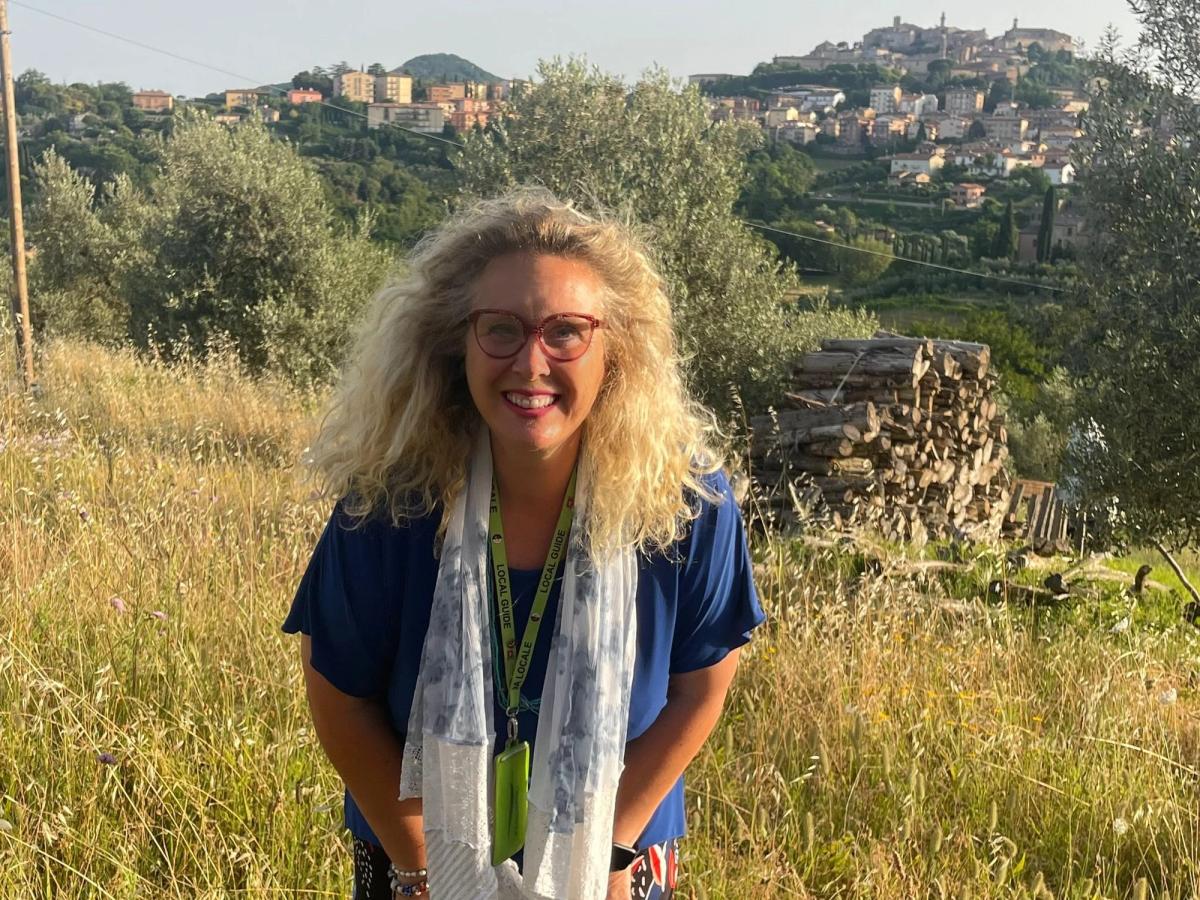

More Tuscany travel info
For more advice on planning your trip to Tuscany, have a look at some of our other guides and itineraries!
Florence
Tuscany
